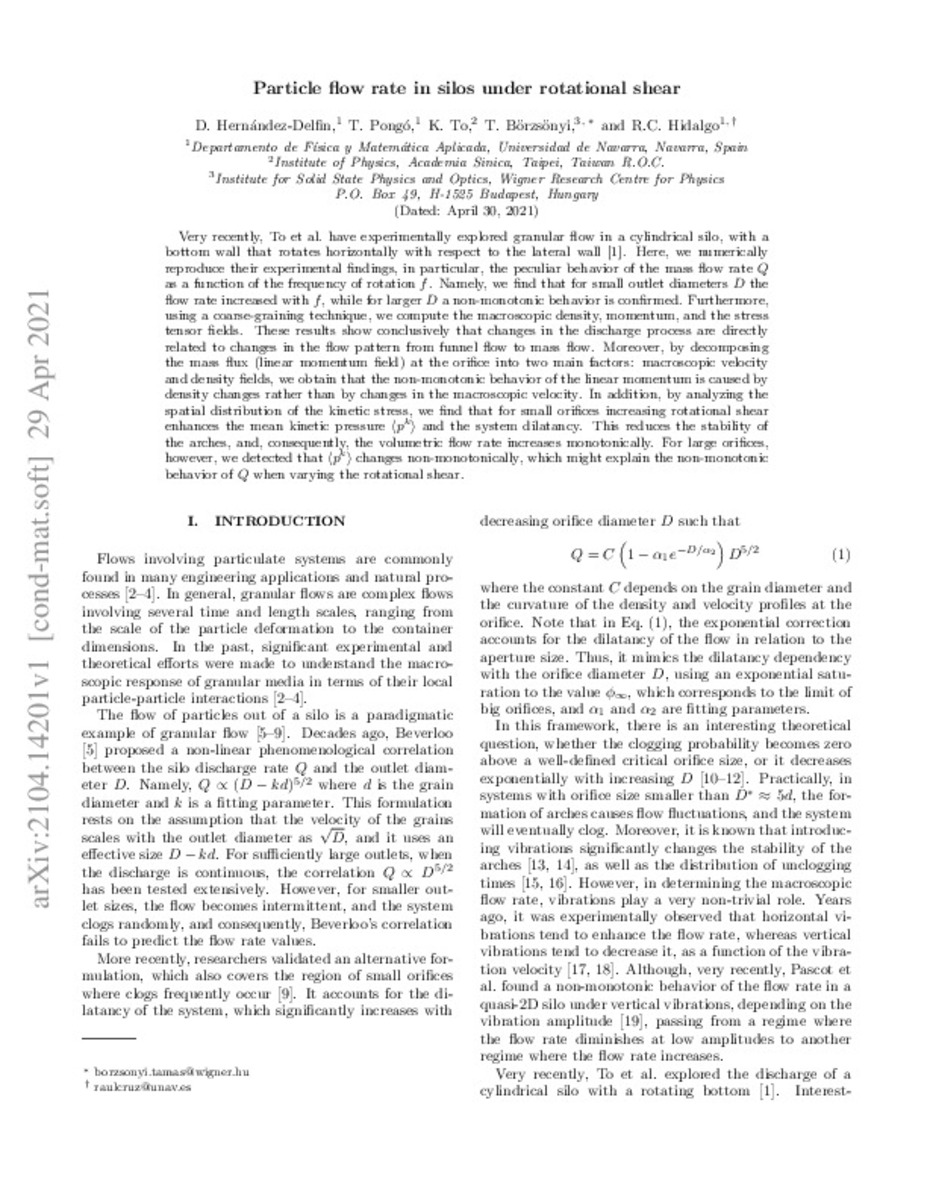Full metadata record
| DC Field | Value | Language |
|---|---|---|
| dc.creator | Hernández-Delfín, D. (Dariel) | - |
| dc.creator | Pongó, T. (Tivadar) | - |
| dc.creator | Börzsönyi, T. (Tamás) | - |
| dc.creator | Cruz-Hidalgo, R. (Raúl) | - |
| dc.date.accessioned | 2023-01-13T15:22:39Z | - |
| dc.date.available | 2023-01-13T15:22:39Z | - |
| dc.date.issued | 2020 | - |
| dc.identifier.citation | Hernández-Delfín, D. (Dariel); Pongó, T. (Tivadar); Börzsönyi, T. (Tamás); et al. "Particle flow rate in silos under rotational shear". Physical Review E. 102, 2020, 042902 | es_ES |
| dc.identifier.uri | https://hdl.handle.net/10171/64987 | - |
| dc.description.abstract | Very recently, To et al. have experimentally explored granular flow in a cylindrical silo, with a bottom wall that rotates horizontally with respect to the lateral wall [Phys. Rev. E 100, 012906 (2019)]. Here we numerically reproduce their experimental findings, in particular, the peculiar behavior of the mass flow rate Q as a function of the frequency of rotation f . Namely, we find that for small outlet diameters D the flow rate increased with f , while for larger D a nonmonotonic behavior is confirmed. Furthermore, using a coarse-graining technique, we compute the macroscopic density, momentum, and the stress tensor fields. These results show conclusively that changes in the discharge process are directly related to changes in the flow pattern from funnel flow to mass flow. Moreover, by decomposing the mass flux (linear momentum field) at the orifice into two main factors, macroscopic velocity and density fields, we obtain that the nonmonotonic behavior of the linear momentum is caused by density changes rather than by changes in the macroscopic velocity. In addition, by analyzing the spatial distribution of the kinetic stress, we find that for small orifices increasing rotational shear enhances the mean kinetic pressure (pk) and the system dilatancy. This reduces the stability of the arches, and, consequently, the volumetric flow rate increases monotonically. For large orifices, however, we detected that (pk) changes nonmonotonically, which might explain the nonmonotonic behavior of Q when varying the rotational shear. | es_ES |
| dc.description.sponsorship | European Union’s Horizon 2020 research and innovation programme under the Marie Sklodowska-Curie Grant CALIPER No. 812638, by the Spanish MINECO (FIS2017-84631-P MINECO/AEI/FEDER, UE Projects), and by the NKFIH (Grant No. OTKA K 116036). D.H. acknowledges Asociación de Amigos de la Universidad de Navarra. | es_ES |
| dc.language.iso | eng | es_ES |
| dc.relation | info:eu-repo/grantAgreement/AEI/Proyectos I+D /FIS2017-84631-P/ES/FLUJO INTERMITENTE EN EL PASO POR ESTRECHAMIENTOS DE SISTEMAS DE MUCHAS PARTICULAS | es_ES |
| dc.rights | info:eu-repo/semantics/openAccess | es_ES |
| dc.title | Particle flow rate in silos under rotational shear | es_ES |
| dc.type | info:eu-repo/semantics/article | es_ES |
| dc.identifier.doi | 10.1103/PhysRevE.102.042902 | - |
| dadun.citation.publicationName | Physical Review E | es_ES |
| dadun.citation.startingPage | 042902 | es_ES |
| dadun.citation.volume | 102 | es_ES |
Files in This Item:
Statistics and impact
Items in Dadun are protected by copyright, with all rights reserved, unless otherwise indicated.






